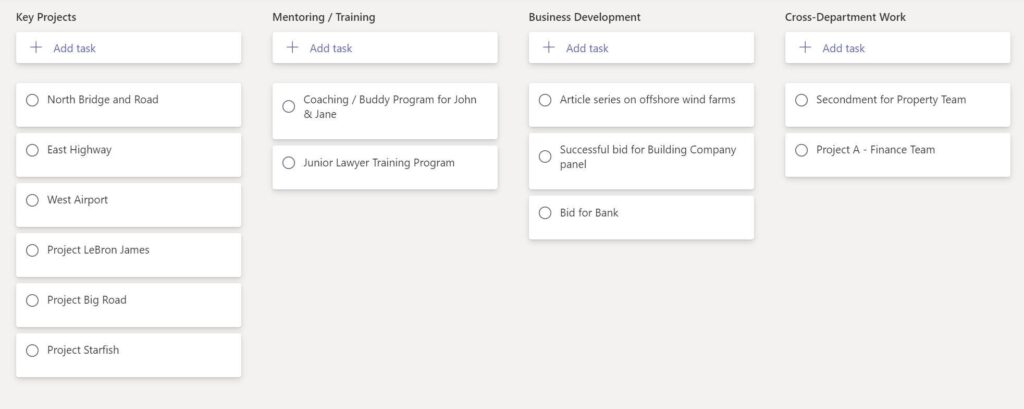Getting a promotion doesn’t come from just working hard and hoping for the best.
Unless you have an amazing sponsor, you’ll probably need to learn and drive the promotion process yourself. As an 8 year qualified lawyer, I made my fair share of mistakes when applying for promotions at law firms.
Here’s what I’ve learned – hopefully it helps newer lawyers map out their career development with more success.
This step-by-step guide covers:
- the guiding principles behind success in promotion applications;
- the actions you should take to plan out and successfully implement your promotion strategy; and
- a recommended timeline for your promotion application.
Guiding Principles
Most people start the promotion process too late. The best time is 6-12 months before the application date. This gives you enough time to gather evidence of your achievements, work on any shortcomings in your promotion application and align with your manager / stakeholders before budgets and resourcing is locked in.
Doing well in your current role is a pre-requisite for successfully applying for the next level, but often applicants aren’t able (or prepared) to quantify their competence. Setting up a tracker for your contributions throughout the year really helps with this (I use Microsoft Planner).
You don’t need to be perfect at every promotion criteria, but you do need to understand what the criteria is, craft a narrative focusing on your strengths and give yourself enough time to identify and fix up your weaknesses.
It’s okay to try for a promotion before you feel completely ready. Even if your first attempt is unsuccessful, there will be things that you learn from the experience that will make it harder for them to say no the second time. Better to apply a year early than a year late.
Understand that there will be things outside of your control in determining whether your promotion will be successful or not (e.g. budget and resourcing constraints, stakeholders who aren’t fond of you for non-work reasons, economic conditions etc). The goal of this guide is to focus on the things that are within your control and maximise your chances as much as possible.
A Step-by-Step Guide to your Promotion Application
Step 1 – Promotion process (timing, forms to submit, people in approval process)
The first step is to understand exactly what the promotion process at your organisation looks like. For bigger organisations, there is often a promotion application policy that would map out what’s required. If your organisation doesn’t have one, then I’d suggest asking your coworkers and manager about what is involved in applying for a promotion.
The key things to look out for / get information on are:
- Timing – what are the application deadlines and how many times a year are the roles open for promotion
- Forms to submit – this could include an application form, competency matrix, feedback from stakeholders etc.
- Promotion Criteria – e.g. years of experience, measures of competency, what you’re being assessed on (e.g. leadership, technical skills, billable / pro bono hours, business development)
- Stakeholders in the approval process – e.g. your manager, your direct reports, others outside of your direct team
- Barriers to promotion – e.g. X% of time entries being submitted within 3 days (found out about this one myself the hard way…)
Step 2 – Discussion with manager / others in approval process
About 6-12 months before the application date, you should have a discussion with your manager (and, if required, others in the approval process).
This is to let them know that you intend to apply for the promotion, identify any areas you may need to improve on, and agree on goals to achieve that would maximise your chance of success in the application.
Here’s how I’d approach this:
Let them know you intend to apply for the promotion and set up a meeting to discuss this in detail
“Hi John, I’ve been thinking about how I’m performing in my current role and feel like I’m ready to take the next step. The promotion process for [Associate] starts [next June] and I’d like to start preparing for it soon. Could we find some time [next week] to discuss how I’m currently performing and any steps that I’d need to take to improve my chances with applying for that role?”
Preparing for the meeting
To prepare for the meeting, you should look through the promotion criteria and map out the areas that you feel like you meet or excel in, as well as the areas that you may need some improvement in.
In the meeting
The meeting should be about reflecting on your performance in your current role and working through the promotion criteria with your manager.
Sometimes, your manager might have a different impression to you on certain things but remember that this meeting isn’t about selling / defending yourself – it’s about understanding the potential strengths and weaknesses of your promotion application with the benefit of another person’s view.
The outcomes of the meeting should be to:
- discuss areas of strength and improvement;
- take note of any objections; and
- agree on your goals and actions, and the assistance / opportunities that your manager can provide.
Set this out in an email / memo
“Hi Jane, Thank you for your time this afternoon - it was very helpful! I’ve set out a record of our discussion and the outcomes that I will focus on over the next [9 months] to improve my promotion application for the [June 2025 Senior Associate intake]. [insert outcomes from the discussion]”
Step 3 – Set up system for tracking and achieving the criteria / areas to improve
One of my favourite systems is to use a Kanban board. It’s even better if you can insert copies of emails, work product etc. but you can also just save those separately in a Windows or inbox folder.
Here’s what an example might look like:

To set up your own (using a program like Microsoft Planner, Notion, Asana, Trello etc.):
- Choose a few areas to focus on (from the promotion criteria and discussion with your manager)
- Set up categories for those areas and identify some targets, actions or initiatives that you would do in relation to those categories
- Over time, document your achievements, save the feedback / good work product that you produce in relation to those criteria, and quantify them for later use in your promotion application. For example:
“Working with other departments – For the month of June, I assisted the litigation team with an urgent hearing in relation to [insert] as they did not have sufficient resources. This involved [reviewing over 10,000 documents in a discovery process, legal research on X and preparing draft submissions]. My work received good feedback and the cross-department help was appreciated (see attached email from [litigation partner]).”
Step 4 – Write up your promotion application
Every firm’s promotion application form will be a bit different, but will generally ask you to address how you meet the promotion criteria.
As we noted, trying to explain how you meet every single criteria in detail could weaken your overall narrative (especially where you have a limited word count).
So you might want to incorporate this sort of approach:
“I have reviewed the promotion criteria and believe that I meet all of the requirements for the promotion while excelling in my current role. While I am happy to provide further detail on how I satisfy each of the criteria, the unique strengths that I bring to the next level are:
[insert strengths and evidence from your tracker]
Further, areas that I had focused on improving over the past [6 months] in preparation for this promotion are:
[insert areas and evidence of improvement from your tracker]”
I also suggest asking your colleagues (especially those who have been through this promotion process recently) whether they could share their applications with you.
Step 5 – Remind manager and ask for opinions on the promotion application
Often, your manager can help you fine-tune your application while also adding their experience as somebody who has probably been through promotion processes or even reviewed and approved promotions.
Step 6 – Submit all relevant forms
Make sure everything that you need to submit with your application. It could be handy to prepare a checklist to make sure you’re not missing anything if there are many documents involved.
Step 7 – Follow up if the promotion was unsuccessful this time
If your application isn’t accepted, it’s not the end of the road. By going through the application process, you can figure out exactly where you should focus on improving for success next time.
By taking on board constructive feedback from the process and your manager, you can develop and agree on a much more targeted plan to tackle any development areas. The people who assess your application next time don’t just look at what you’ve put forward as your accomplishments – they also value seeing what you’ve done to address any areas of improvement since the last application.
Summary
- Get an understanding of the promotion process, timeframes and criteria in your organisation. This might be set out in a promotion guidelines document, or can be checked with your manager.
- Have a discussion with your manager (and, if required, others in the approval process). Let them know that you intend to apply for the promotion, identify any areas you may need to improve on, and agree on goals to achieve that would maximise your chance of success in the application.
- Set up a system for tracking and achieving the criteria / areas to improve – I recommend using a Kanban style tracker like Microsoft Planner, Asana or Trello.
- Write your promotion application in a way that crafts a narrative based on a few detailed criteria that highlight your strengths and improvements (not trying to tick off every single criteria). Try to get examples from your colleagues who have gone through the promotion process.
- Follow up if the promotion was unsuccessful – assessors appreciate seeing growth since the last application and it’s much likelier to be successful next time.
Timeframe:
- 12-15 months out– Learn about your organisation’s promotion process (deadlines, forms to submit, promotion criteria, stakeholders in the approval process)
- 6 – 12 months out – Have a discussion with your manager to let them know that you intend to apply for the promotion, identify any areas you may need to improve on, and agree on goals to achieve that would maximise your chance of success in the application.
- 6 – 12 months out – Choose a few promotion criteria to focus on and set up a system to track and quantify your contributions towards those criteria in your current work.
- 1 month out – Write up a draft promotion application (ask your colleagues if they can share theirs)
- 2-4 weeks out – Remind your manager and ask if they could review and provide feedback on your draft application.
- Submission – good luck!
Looking for some help with training early career lawyers?
For the past 4 years, I’ve been writing practical how-to guides for junior lawyers and providing training for law firms both large and small.
If you’d like to work with me to tailor a training program for your organisation’s learning and development needs, please send me an email at jason.feng@live.com.au and I’ll send you the guides that I’ve presented for other law firms and in-house teams.
Finally, if you’re a junior lawyer looking for practical career advice – feel free to browse the other how-to guides on this website and / or sign up for the free newsletter to stay updated!
